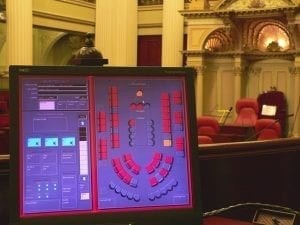Victoria Parliament House, Melbourne, AV Systems Upgrade

Parliament House, Melbourne, VIC Australia
Description
Construction of the Parliament House of Melbourne was begun in 1856, but this seat of power for the Australian state of Victoria remains unfinished and ever changing – including the IT and audio systems in place.
Law and tradition require that every word spoken during a session of Parliament or related Committees be transcribed into writing. While originally accomplished in real time with shorthand or stenography machines, this task has shifted in modern times to a system of recording and transcribing audio.
At the Parliament of Victoria, a mix of digital and analogue methods is used to capture this audio, which must then be sent to a central equipment area where it is processed and distributed to recorders, video and audio broadcast monitors, PA amplifiers, in house and remote Parliament offices, the Press and other stakeholders.
Challenge
The primary challenge is to properly capture intelligible audio in the wide variety of rooms and chambers within the House of Parliament. These rooms vary considerably, and different recording methods are appropriate for each. In the past this presented a problem of moving equipment from place to place, overcoming challenges of old building infrastructures, long and difficult cable runs, and even electric trams and trains running adjacent to and beneath the Parliament buildings.
Solution
In 2006-2007, the Parliament House underwent an overhaul of the existing IT network, the result being a modern system that is fast, reliable and well managed. The quality and capability of this network made possible new audio and video technologies to replace and improve upon the massive older VicControlScreenanalogue cabling system of the past.

Audinate’s Dante™ is a natural fit for such an environment, being a completely standards-based implementation of digital audio transport that runs over common IP networks without the need for special hardware, cabling or separation from other data traffic.
A solution was developed using Dante-enabled products from Peavey’s Media Matrix line. Media Matrix CAB4n units within House chambers allow audio from room microphones to be digitized and transported over the network to Media Matrix NIONs located in a central processing area. From this point audio can be transported and processed as needed to fulfill the mandate of Parliament.
Because the network is available in virtually every room of the building, sound engineers can quickly and easily connect to the larger system without the need for long runs of audio cables. They simply connect to the ubiquitous Ethernet ports along the walls.

The design consultants and AV integrators are extremely pleased with how Dante has performed, and are currently in the process of implementing monitoring stations utilizing PCs running the revolutionary Dante Virtual Soundcard software.
 Further expansions of Dante in the Parliament House include use of the Dante PCIe Soundcard to record audio directly to servers, and the installation of Dante Netspander™ to allow the audio network to extend to remote Parliamentary and Committee sittings.
Further expansions of Dante in the Parliament House include use of the Dante PCIe Soundcard to record audio directly to servers, and the installation of Dante Netspander™ to allow the audio network to extend to remote Parliamentary and Committee sittings.
Consultants and Integrators
The Audio Project, along with the Video Project, was installed, and is supported by Audio Visual Image’Nation. AVI is located in Perth, and has offices throughout Australia.
- Project Manager for all work at the Parliament of Victoria was Mick O’Niell
- Design consultant: Rod Brown
- Design consultant: John White of WhiteNoise located in Port Douglas, Queensland



